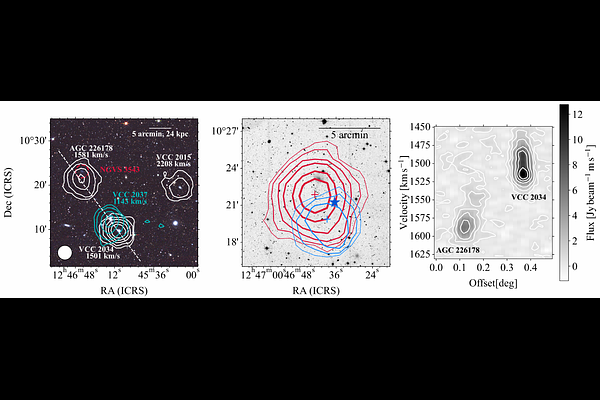Unveiling the Nature and Fate of the Almost-Dark Cloud AGC 226178 through HI Mapping

Unveiling the Nature and Fate of the Almost-Dark Cloud AGC 226178 through HI Mapping
Yu-Zhu Sun, Hong-Xin Zhang, Elias Brinks, Rory Smith, Fujia Li, Minsu Kim, Se-Heon Oh, Zesen Lin, Jaebeom Kim, Weibin Sun, Tie Li, Patrick Côté, Alessandro Boselli, Lijun Chen, Pierre-Alain Duc, Sanjaya Paudel, Matthew A. Taylor, Kaixiang Wang, Enci Wang, Lanyue Zhang, Yinghe Zhao
AbstractThe origin of extragalactic, almost dark HI clouds with extreme gas-to-stellar mass ratios remains poorly understood. We investigate the nature and fate of the "almost dark" cloud AGC 226178, projected within the Virgo cluster, with an HI-to-stellar mass ratio of ~1000. We present deep single-dish HI mapping from the Five-hundred-meter Aperture Spherical Telescope (FAST), complemented by high-resolution interferometric data from the Very Large Array (VLA), as part of the Atomic gas in Virgo Interacting Dwarf galaxies (AVID) project. These observations provide the highest-quality HI analysis to date of such a cloud, combining resolution and sensitivity. FAST data reveal a short, low-velocity tail toward the dwarf galaxy VCC 2034, previously proposed as a possible origin for AGC 226178. However, VCC 2034 shows a line-of-sight asymmetric HI feature and cometary morphology indicating a stripping event unrelated to AGC 226178. VLA data reveal a velocity gradient across AGC 226178 and a clumpy internal structure. The velocity dispersion exceeds the thermal linewidth, implying turbulence or unresolved motions. The cloud cannot be gravitationally bound by atomic gas alone. The resolved HI clumps follow standard HI mass-star formation rate and mass-size relations, with those forming stars reaching surface densities above the threshold for self-shielding. We conclude that AGC 226178 is a free-floating HI cloud of unknown origin. The system appears to be in the process of disintegration. It is likely located well outside the Virgo cluster, as the preservation of its extended HI morphology within the cluster environment would otherwise require a substantial reservoir of unseen molecular gas with a mass exceeding that of the observed HI content. While confinement pressure from the hot intracluster medium may aid its stability, it is unlikely to be the dominant factor preventing its disruption.